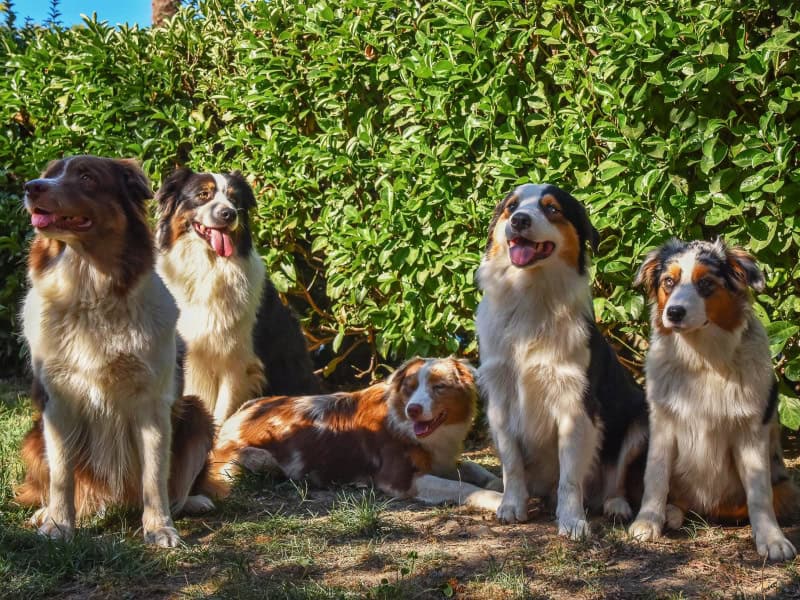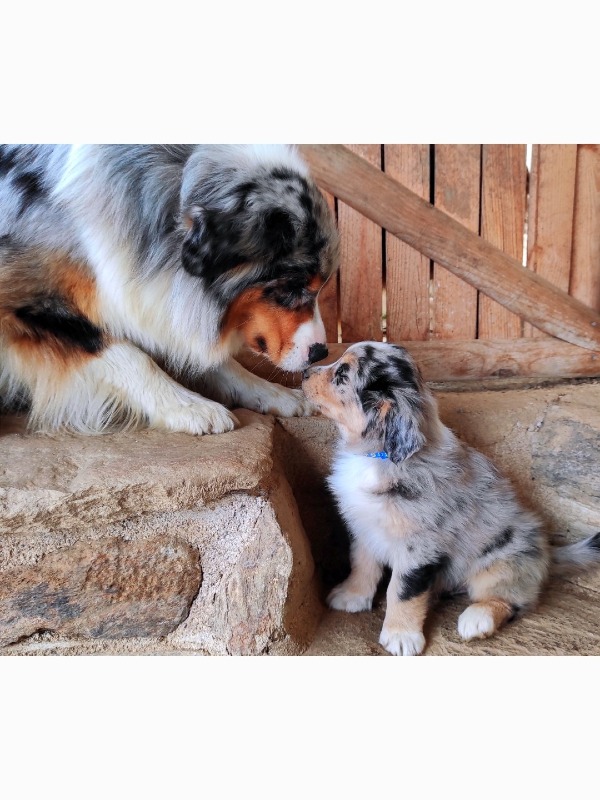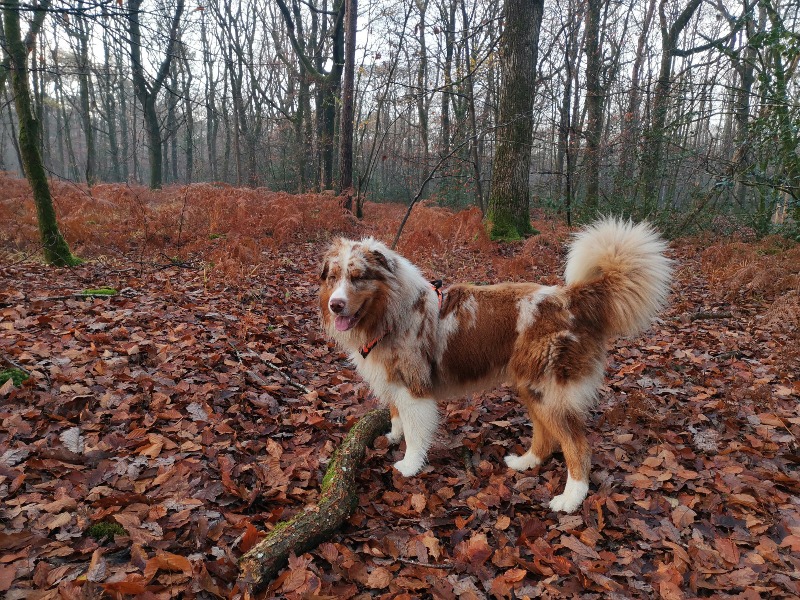Australian shepherd
Autres noms : Aussie
Discover the Australian Shepherd, an intelligent, energetic, and affectionate dog, ideal for families and outdoor enthusiasts. With its elegant coat and herding instinct, it excels in canine sports and an active lifestyle. Adopt this loyal and dynamic companion!
Awareness of acquiring an animal
Adopting or breeding a dog is a responsibility that must be carefully considered. Dogs are loyal companions that require time, attention, and constant care. Whether for leisure, passion, or professional breeding, it is crucial to understand the specific needs of each breed. Provide them with a loving and stimulating environment, and avoid any impulsive acquisition that could harm their well-being. Be a vigilant and committed owner for a happy and healthy companion.
To learn more about animal welfare, we invite you to consult our FAQ by clicking the button below:
Origins and history
The Australian Shepherd finds its origins in Europe, where herding dogs were used to guide and gather livestock. In the 19th century, breeders in Australia developed this breed, drawing inspiration from these European dogs to create a breed suited to the vast lands and austere climate of the country. Their goal was to produce a particularly agile and intelligent dog capable of efficiently managing sheep herds.
Over time, the Australian Shepherd gained popularity, especially among farmers and ranchers. Its hard-working ability, sharp mind, and sociability made it a valuable companion both professionally and personally. The dogs were often used in herding competitions and participated in various canine activities, such as agility and obedience.
Today, this breed is appreciated not only as a working dog but also as a pet. Characteristics such as loyalty, intelligence, and ease of learning continue to attract dog enthusiasts, making the Australian Shepherd one of the most sought-after breeds in the world.
Physical characteristics
The Australian Shepherd is a medium-sized dog with a robust and athletic build, designed for work. Its height at the withers usually ranges from 46 to 61 centimeters, while its weight varies between 14 and 32 kilograms. This size gives it great agility, which is essential for its role as a herding dog.
The coat is one of the most distinctive characteristics of this breed. It is double-coated, with a woolly undercoat and a longer, weather-resistant outer coat. The colors vary, including blue merle, black, red merle, and solid red, often featuring white or tan markings, particularly on the chest and legs. This coat requires regular maintenance to prevent tangles and maintain its health.
The eyes of the Australian Shepherd are often very expressive, and can come in various colors, ranging from brown to blue, and sometimes even one of each color. The ears are medium-sized, slightly rounded, and can either be held in a rose position or stand upright. Finally, its tail may be long or short depending on the individual, but it is generally well-proportioned to the body. This mix of physical characteristics contributes to its beauty and functionality as a working dog.
Character
The Australian Shepherd is a highly valued dog for its many qualities. It stands out for its exceptional intelligence and quick learning ability. This breed is often used in working roles, particularly for herding, which highlights its agility and determination. Their ability to understand and perform complex tasks makes them ideal companions for active families and those looking for a loyal partner.
The Australian Shepherd's boundless energy is another notable trait. These dogs are dynamic and require daily physical activity to stay healthy and happy. Regular walks, interactive play, and mental stimulation exercises are essential to channel their energy. Without adequate exercise, they can develop destructive or bored behaviors.
In terms of personality, these dogs are affectionate and loyal to their family. They form strong bonds with their owners and are often protective. This can sometimes make them a bit wary of strangers, but this characteristic can be mitigated with proper socialization from a young age. In summary, the Australian Shepherd is a faithful, energetic, and intelligent companion, ideal for those seeking dynamic and affectionate interaction.
Life expectancy
The life expectancy of an Australian Shepherd is generally between 12 and 15 years. This range can vary depending on several factors, including genetics, diet, level of physical activity, and regular veterinary care. Healthy dogs that are fed a balanced diet and engage in adequate physical activity tend to live longer.
Living conditions also play a crucial role in the longevity of this breed. Dogs that live in a healthy environment, with enough space to move around and play, are often happier and healthier. Preventive care, such as regular vaccinations and health check-ups, helps prevent common diseases that could impact their lifespan.
Finally, the tendency to adopt an active lifestyle with an Australian Shepherd can also influence its life expectancy. This breed is known for its energy and need for exercise. A dog that is regularly physically and mentally stimulated is less likely to develop health issues associated with obesity or boredom. Therefore, taking a proactive approach to care and activity can contribute to maximizing the lifespan of a dog of this breed.
Exercise and activity needs
The Australian Shepherd is a very active and energetic dog breed that requires a high level of daily exercise to stay healthy and happy. Originally bred to work with livestock, these dogs have a strong work instinct and need stimulating physical activities. On average, it is recommended to provide them with at least 60 to 90 minutes of exercise per day, including walks, runs, and interactive play.
Varied activities such as agility, frisbee, or canicross are particularly beneficial for stimulating both their body and mind. These dogs also develop a need for social interaction and love spending time with their owners or other dogs. Early and ongoing socialization is therefore essential for their well-being.
Moreover, mental exercises such as puzzle games, riddles, or training sessions can help prevent boredom, which can lead to destructive behaviors. To keep an Australian Shepherd fit and thriving, a regular and varied exercise routine is essential. Proper physical and mental stimulation will foster a harmonious relationship between the dog and its owner.
Recommended diet
The Australian Shepherd's diet must be carefully selected to meet its specific nutritional needs. As an active and intelligent dog, it requires a diet rich in protein, ideally based on quality meat, to support its muscle mass and energy levels. Animal proteins should make up a significant percentage of its food, supplemented with complex carbohydrates to provide the necessary energy for its activities.
Healthy fats, such as those from fish or chicken oils, are also essential. They contribute to the health of the skin and coat, which are particularly important for this breed with longer hair. Additionally, omega-3 and omega-6 fatty acids promote good cognitive function, which is crucial for such an intelligent dog.
It is crucial to avoid foods containing unnecessary fillers like refined grains or by-products. Opt for kibble formulated specifically for active or sporting dogs, or consider a homemade diet under the supervision of a veterinarian. Finally, the amount should be adjusted according to the dog’s age, weight, and activity level to prevent obesity.
Training and obedience
Training and educating an Australian Shepherd requires an approach tailored to the characteristics of this intelligent and energetic breed. Due to their genetic background as working dogs, these animals need regular mental and physical stimulation. Daily exercise sessions, combined with playful and interactive activities, are essential for channeling their energy, reducing destructive behaviors, and fostering a good emotional balance.
Socialization is also crucial. Exposing the dog to various environments, people, and other animals from a young age will help them develop a balanced personality and prevent potential fears or aggressive behaviors. Group socialization classes are an excellent way to help them adjust and learn to interact with their peers.
Positive training is recommended for this breed. Using rewards, such as treats or praise, encourages the dog to respond to commands. Consistency in training methods is vital for them to understand what is expected of them. It is also wise to start training at a young age, as these dogs learn quickly. Obedience exercises, control, and specific disciplines such as agility can enrich their daily life while providing them with stimulating challenges.
Behavior with children
The behavior of Australian Shepherds with children is generally positive, but it largely depends on their training and socialization. These dogs are known for their energetic nature and intelligence, which often makes them very receptive to interactions with younger kids. They have a natural protective instinct and are often very devoted to their family. This translates into a willingness to play and entertain children, which can strengthen family bonds.
However, it is crucial to teach children how to interact properly with these dogs. Establishing rules regarding the respect of the animal’s personal space is essential. Abrupt or uncontrolled behaviors can disturb the dog, which may react unpredictably. Training should also include socialization sessions from a young age for the dog, so it becomes accustomed to the presence of children and their sometimes unpredictable emotions.
Another important point is the need for physical activity for these dogs. They require a lot of exercise and mental stimulation to avoid boredom, which can lead to destructive behaviors. By incorporating interactive games and involving children in activities with the dog, not only are the needs of the Australian Shepherd met, but children also learn values such as responsibility and patience.
In summary, good behavior with children is heavily influenced by training and environment. If interactions are guided and respectful, the Australian Shepherd can become a loyal and joyful companion for young ones, bringing a positive dynamic to the family.
Compatibility with Other Animals
The Australian Shepherd is a dog breed known for its intelligence and energy. When it comes to compatibility with other pets, several factors need to be taken into account. In general, this breed has a well-developed herding instinct, which can influence its interactions with other species.
In a household where other animals coexist, such as cats or small mammals, the Australian Shepherd can be both friendly and protective. However, it is essential to socialize the dog from a young age. Positive exposure to various animal species can help it develop balanced behavior. The lack of socialization can lead to predatory behaviors, especially with smaller animals.
Australian Shepherds usually get along well with other dogs, particularly if they are raised together or introduced gradually. They need an active companion to share their energy with. In summary, with proper socialization, this breed can coexist harmoniously with other pets. However, owners must remain vigilant and be ready to intervene if tensions arise.
Grooming needs
The Australian Shepherd is a dog breed that requires regular grooming due to its dense double coat, which consists of a soft undercoat and a weather-resistant outer layer. Weekly brushing is recommended to prevent tangles and matted fur, especially during shedding seasons. During these times, it is advisable to increase the brushing frequency to two or three times a week. This helps reduce the amount of fur lost in the house while keeping the skin and coat healthy.
Regarding maintenance, it is essential to monitor the ears, teeth, and nails. The ears should be checked regularly to prevent any accumulation of dirt or moisture that could lead to infections. The teeth should be brushed frequently to prevent dental issues. As for the nails, they should be trimmed regularly to avoid discomfort while walking. Proper maintenance not only contributes to the animal's physical health but also fosters a close bond between the dog and its owner.
Health
The Australian Shepherd is an active and intelligent dog breed, valued for its role as a working dog and family companion. However, like any breed, it has predispositions to certain health conditions. Eye problems, such as cataracts and retinal dysplasia, are common. Therefore, it is essential to monitor eye health from the early months.
Hip dysplasia is another major concern. This joint malformation can lead to arthritis and pain in adulthood. Early screening and an appropriate exercise program can help minimize complications. It is also important to monitor weight, as obesity can exacerbate these joint issues.
Due to their high energy level, their exercise needs are significant. A lack of physical activity can result in destructive behaviors and anxiety. At the same time, a balanced diet is crucial for maintaining their weight and overall health. Finally, regular veterinary visits for routine check-ups are essential for detecting and preventing health problems.
Environment and habitat
The Australian Shepherd is a breed of dog that originated in the United States, although it may have influences from European herding dogs. Its natural environment is often associated with vast expanses and agricultural land, as it was initially bred to work with livestock. Adapted to various climates, it can thrive in both warm and cool areas, but it prefers open spaces and outdoor activities.
Regarding its ideal habitat, the Australian Shepherd requires plenty of space to expend energy. A fenced yard or a large area is favorable, as it benefits from an environment where it can run and play freely. It is also essential to provide appropriate mental and physical stimulation. Activities such as agility, hiking, and fetch games are recommended to prevent boredom and maintain its well-being.
Finally, this breed is sociable and enjoys human companionship. It flourishes in a household where it can interact regularly with family members. Integration into an active and dynamic lifestyle is essential for a good physical and emotional balance.
Name ideas
Choosing a name for an Australian Shepherd is an important task, as the name should reflect the animal's personality while being easy to pronounce and remember. It is advisable to base the name on characteristics of the breed, such as its intelligence, energy, or sociable nature. A good name should not be too long, allowing the dog to quickly associate it with its actions and commands. Additionally, it's helpful to choose a name that does not sound similar to other commands to avoid any confusion during training sessions.
Furthermore, names inspired by nature or Australian culture can evoke the breed's origins, adding a touch of authenticity. Also, consider names that are simple for all family members to pronounce. Finally, it might be wise to test the name by calling your Australian Shepherd to see how it reacts.
Here are about fifteen name suggestions for an Australian Shepherd: Astro, Zora, Kiwi, Blaze, Juno, Rusty, Skye, Ember, Finn, Willow, Boomer, Poppy, Dash, Coco, and Nova.
Average purchase price
The price of a purebred dog can vary based on several factors, and the Australian Shepherd is no exception. Generally, the cost of a puppy ranges between 600 and 2,000 euros. Several elements influence this price range, including the breeder's reputation, the puppy's genetics, and the parents' championship titles.
Location also plays an important role. In some regions, the demand for this breed is higher, which can lead to increased prices. Additionally, reputable breeders often charge higher rates, ensuring appropriate veterinary care and proper socialization for the puppies.
It is also crucial to consider the additional expenses associated with acquiring a dog. Costs for food, veterinary care, training, and equipment can quickly add up, making the financial commitment more significant in the long run.
In conclusion, it is essential to conduct thorough research and turn to responsible breeders to ensure a good investment in a loyal companion.
Expenses
Owning an Australian Shepherd involves planning for various types of monthly expenses. On average, it's important to consider food costs, which can range from 40 to 80 euros per month. A balanced diet is essential for the dog's health, which may include high-quality kibble or wet food.
In addition, veterinary care should be taken into account. Vaccinations and annual check-ups can add up to about 15 to 25 euros per month if you spread the cost of care over a year. Don't forget preventive treatments against parasites, which can add around ten euros per month.
Expenses related to maintenance and socialization, such as toys and training classes, can reach 30 to 60 euros per month. Dogs of this breed, being very active, also require regular activities, such as walks or outdoor outings, which can incur additional costs.
Finally, it is wise to set aside some funds for unexpected expenses, especially emergency veterinary care, which can easily double or triple your initial monthly budget. In total, monthly expenses can vary between 150 and 300 euros, depending on your choices and your pet's specific needs.
Destination and usage
The Australian Shepherd is a highly valued dog as a pet due to its balanced temperament and intelligence. This breed is distinguished by its affectionate nature, making it an ideal companion for families. Its sociability allows it to get along well with children and other pets, further reinforcing its role within the household.
In addition to being a great companion, the Australian Shepherd requires regular physical activity. This trait makes it particularly suitable for families with an active lifestyle. Daily walks, outdoor games, and activities like agility help channel its abundant energy. This need for exercise and mental stimulation is one of the reasons why it is so popular among outdoor enthusiasts.
Finally, this dog is often involved in various canine sports such as frisbee and flyball. Its ability to quickly learn tricks and perform tasks makes it an excellent partner for training activities. In summary, the Australian Shepherd thrives as a pet thanks to its intelligence, sociability, and need for exercise, making it a favored choice for active dog lovers.
Legislation and regulation
The legislation and regulations regarding the Australian Shepherd dog breed vary considerably from country to country. In many European countries, the breed is generally well accepted and regarded as a good family companion. The laws on pet ownership there are less strict, except regarding health and animal welfare requirements.
In North America, the regulation can be more complex. Some states impose laws aimed at preventing dog bites without specifying particular breeds, but the responsibility of owners is often emphasized. Countries like Canada encourage the socialization and training of dogs, and the breed is often appreciated for its intelligence and skills.
In other regions, such as certain parts of Australia, there may be restrictions regarding the ownership of certain breeds, although this varies at the state and municipal levels. Owners often have to prove that they can meet the specific needs of the breed, particularly in terms of exercise and mental stimulation. Thus, understanding and respecting local laws is essential to ensure a harmonious life with this breed.
Official recognition
The Australian Shepherd is a popular dog breed in many countries, known for its intelligence, versatility, and energetic temperament. In the United States, it is officially recognized by the American Kennel Club (AKC), where it is classified among working breeds. This recognition contributes to the breed's popularity, both in dog competitions and as a pet.
In Europe, several countries have integrated this breed into their dog recognition systems. For example, in France, the Société Centrale Canine has registered it in its book of origins. This ensures a framework for breeding and promoting the breed's standards. Other nations, like the United Kingdom, also have organizations that recognize and promote this breed within their cynological systems.
In countries like Australia, where it originated, local and national organizations are dedicated to preserving and promoting the Australian Shepherd. The official recognition of this breed thus varies from country to country but reflects a growing interest in its unique characteristics and remarkable abilities.
Pedigrees
To obtain a pedigree for an Australian Shepherd, it is essential to go through specialized registries or clubs that oversee breeding and the recognition of breed standards. Among the most recognized organizations, the Fédération Cynologique Internationale (FCI) plays a major role in the international approval of pedigrees. These pedigrees confirm the purity of the breed and the lineage of the dogs.
At the national level, several clubs can also be consulted. For example, the Club Français des Chiens de Traîneau (CFCT) or clubs specializing in herding dogs can provide valuable information and registration services. These clubs organize shows, competitions, and events, allowing breeders to showcase their dogs and validate their compliance with breed standards.
It is recommended to ensure that the breeder is affiliated with one of these registries or clubs to guarantee that the dog is registered properly. This also allows for genealogical tracking and ensures that the dogs bred adhere to rigorous health and behavioral criteria. In summary, these associations are essential for anyone looking to obtain a pedigree for an Australian Shepherd.
Prohibitions
The Australian Shepherd, despite its friendly appearance and dynamic character, may be subject to restrictions in certain countries. These bans often stem from public safety concerns, particularly because they can sometimes exhibit protective or dominant behaviors.
In some European countries, regulations regarding dog breeds may include specific clauses concerning working dogs. This can lead to restrictions for breeders and owners, who must demonstrate that their dog is well-socialized and does not display aggressive behaviors. Training and obedience programs are often required to mitigate the risks associated with these behaviors.
In North America, legislation varies significantly from state to state. Some places impose strict conditions on dogs deemed risky, while others adopt a more permissive approach. Animal protection organizations recommend that owners familiarize themselves with local laws and ensure that their dog is well-trained to avoid legal complications.
It is therefore essential for prospective owners to familiarize themselves with the regulations in their country or region to ensure harmonious coexistence with their companion.
Breeders of Australian shepherd
Want to see more breeders of Australian shepherd?
Check out the page of our directory listing all breeders of Australian shepherdClassified Ads of Australian shepherd
Want to see more ads of Australian shepherd?
Check out the page listing all the ads of Australian shepherdBreed clubs of australian shepherd
No of australian shepherd breed clubs are currently registered on Preeders.
If you would like to highlight your breed club, sign up for free now and be the first to appear on this page.















